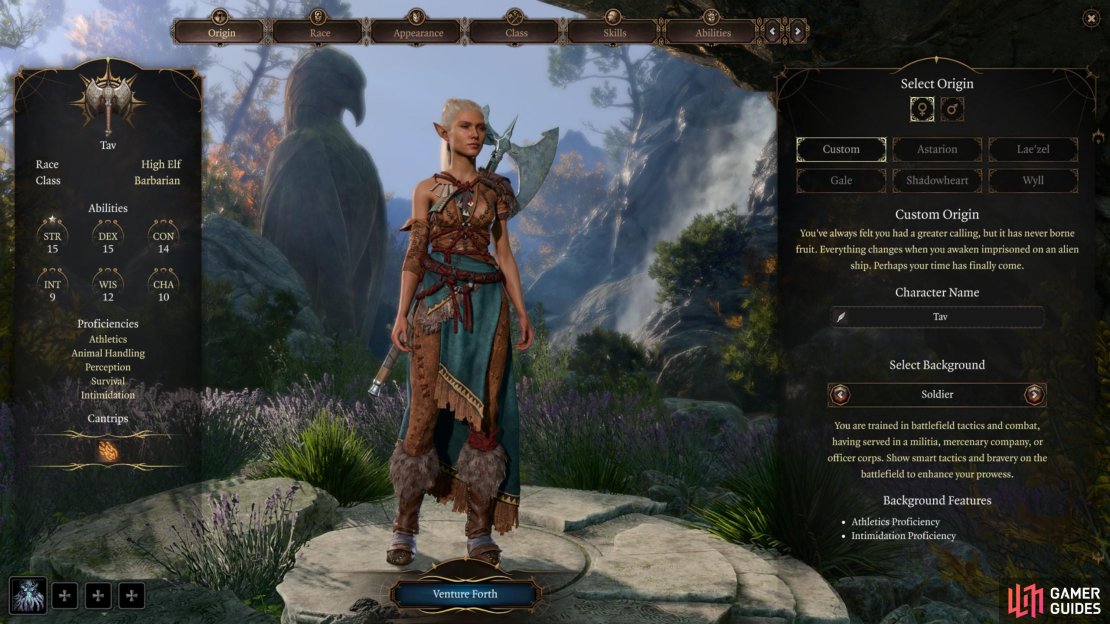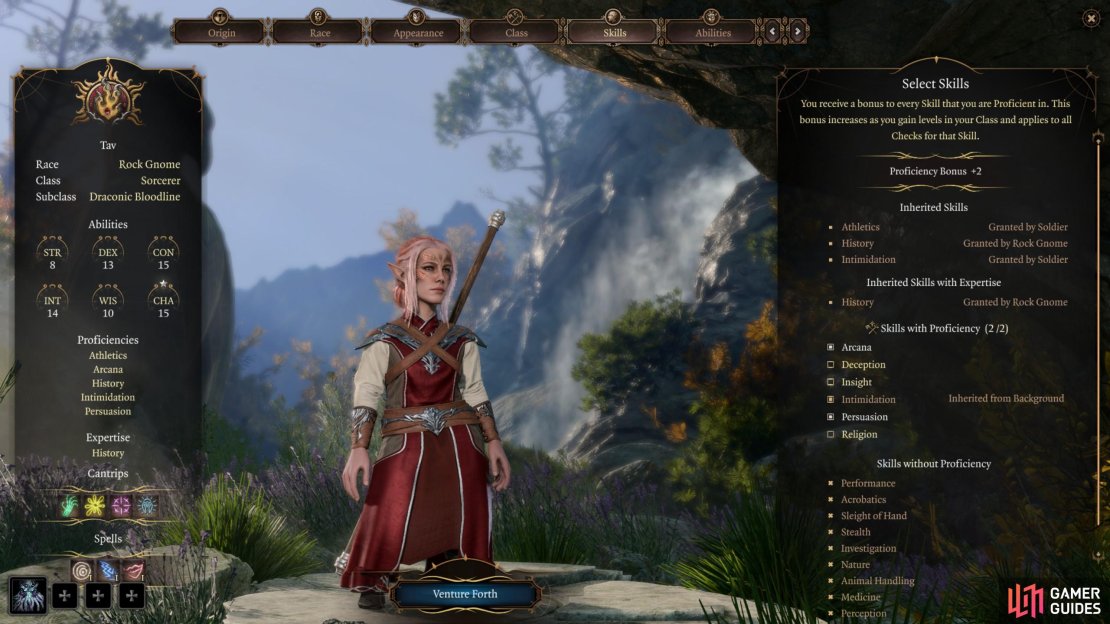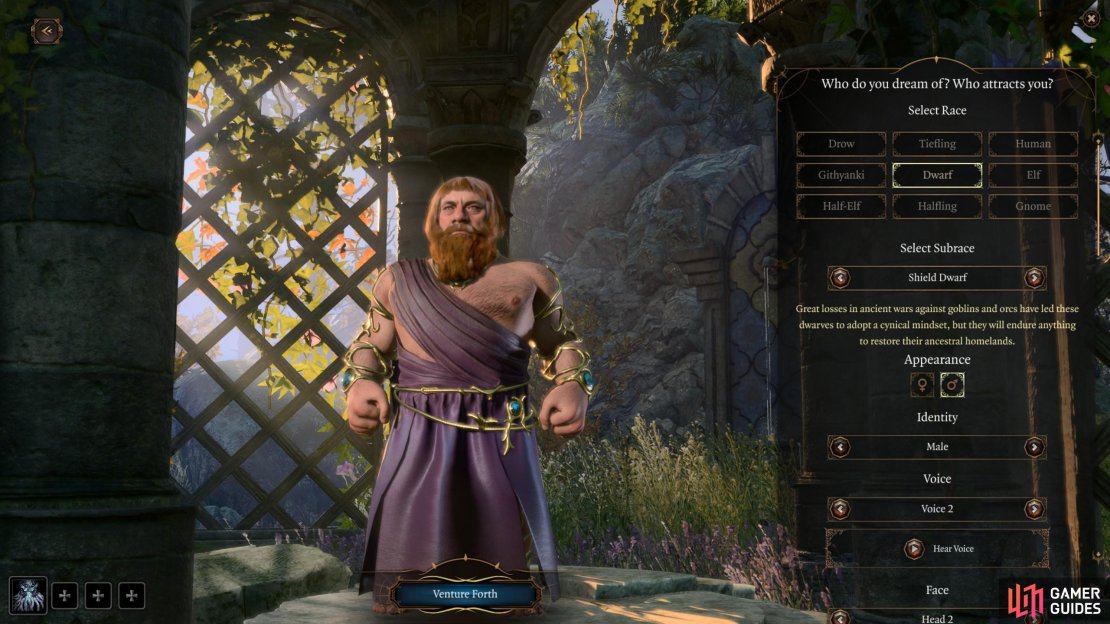The Baldur’s Gate 3 Character creation screen is both a Roleplayers paradise and a Min-maxers heaven. Plenty of the typical fantasy races are available, including all the standard DnD character attributes you can expect. However, there are plenty of customization options to give players almost everything they want from their character’s appearance, personality, background, and of course, attributes. Here’s a closer look at Baldur’s Gate 3 Character Creation, so you can get familiar with your character’s work before setting off into the campaign.
Baldur’s Gate 3 Character Creation Guide¶
Here’s a closer look at what to expect from the Baldur’s Gate 3 Character Creation screen.
Before we get going, let’s take a look at what Baldur’s Gate 3’s character creation offers you from a surface level.
- Origin - Decide whether you are going to play an Origin character, or to create your own character. This will affect dialogue options and voice-over narration, as you will either get a generic custom character or take an origin character with their own fleshed-out story.
- Race - If you play a custom character, you will then select its race, from a wide variation, each with its own racial and story interactions when appropriate.
- Appearance - Affects the look of your character
- Class - Now you decide which Baldur’s Gate 3 Class / Subclass (when applicable) you want it to be.
- Skills - You can decide what your starting spells and cantrips are, depending on your selected class.
- Abilities - this affects your ability scores and attributes that your character has. You can assign ability points at will, or take the recommended racial starting ability points, depending on preference.
- Illithid - You get to create a second character, which is a character that will appear in certain story cutscenes as the game progresses.
Character Creation Screen In More Detail¶
Now it’s time to decide whether you want to role-play a particular race and class combination, or make a min-maxed character with a particular combat focus.
On the Origin screen, you have a few options. This page largely decides who you are, whether you are a custom character or an origin character. Once you’ve decided, you can also see your character’s background and starting origin, which is the usual role-play backgrounds of Noble, Acolyte, Criminal, Sage, Soldier, etc. These will affect certain inspiration points and dialogue options when the time is right. You can also name your custom character here too.
Next up is the Race options. For those making their own character, they can select what race they want to be. The race option comes with a few benefits, such as being able to get racial traits and passive bonuses for role-playing, as well as some in-game combat or exploration benefits. In some instances, you can take a look at various sub-races for each race, with some of them having different lore, dialogue options, and some different passives or starting attributes too.
- Elf: High Elf, Wood Elf
- Tiefling: Asmodeus, Mephistopheles, Zariel
- Drow: Lolth-Sworn, Seldarine
- Human
- Githyanki
- Dwarf: Gold Dwarf, Shield Dwarf,
- Half-Elf, Half Wood, Half High, Half Drow
- Half-Orc
- Halfling: Lightfoot, Strongheart,
- Gnome: Forest, Deep, Rock
- Dragonborn
Once all that is decided, you can then customize your character’s appearance. This comes with a range of skin colors, hairstyles, voice actors, make up styles, tattoos, etc. Just about all the usual character customization you can expect in a game.
Once you’re done making your character all pretty, it’s time to decline the class and where you want to take it.
Now it is time for the class. Either you are going for a theme with your race and class combo, or you are going for the min-maxers approach of getting a decent character creation stat and passive mix, and will use a class to take full advantage of all the modifiers and rolls you can get. Here are all the classes available in the Baldur’s Gate 3 Character Customization.
- Barbarian
- Bard
- Cleric
- Druid
- Fighter
- Monk
- Paladin
- Ranger
- Rogue
- Sorcerer
- Warlock
- Wizard
When you select a class, you can have a few options to come with it. Some classes get to start as a sub-class, while others have little to no options available. The Paladin and Sorcerer, for example, have subclasses from the get-go, while other classes subclasses unlock at levels you get while playing the game. Meanwhile, Bards can select starting spells and cantrips, along with theory starting instruments. Other classes also get to decide on their fighting style earlier, such as Ranger and Fighter for in game bonuses and dialogue role play options in some instances. Moreso, each class has its own starting gear, which is another potential starting factor.
- If you’re gunning for the Min-max approach, why not check out our Baldur’s Gate 3 Tier List?
Moving into the skills section of the Character Creation of Baldur’s Gate 3 comes with the rest of your character sheet details. Here, you can see all the skills you get via your race, background and class options. You may also get to change your skills with proficiencies around if you want to from a very limited list. It is really just a place to figure out where exactly you stand with your various race and other starting factors, so you can double-check what you have, and if you’re doubling up somewhere, change a few things around.
Now, it is Abilities time. The abilities page on the Baldur’s Gate 3 character creation screen shows players their borderline finalized starting attributes. If you’re happy with your chosen race, you can go right ahead. But, if you want to fine-tune your race and class combo ever so slightly or roll your starting attribute scores for some more traditional DnD character creation options, you can now alter them at your pleasure.
The Second Character Creator Screen in Baldur’s Gate 3¶
Nothing screams an attractive campaign-related character more than a dwarf who wants to take you to the pub.
Now you have done everything you can to your character, you will now make a second character. This character is someone that will appear in your dreams and other cutscenes throughout the campaign. And so, this character will be important in the game moving on. You can make them as pretty, waifu tier, or as ugly as you want. It can also be any race you want them to be too. Do with this as you will, as these characters will come to haunt, persuade, or tempt you through the various stages of the game for whatever reason. So, design them, for however you plan on handling those moments in the game and go from there.




No Comments